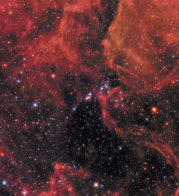
Since the discovery of high-energy extragalactic neutrinos by the IceCube collaboration in 2013, the hunt for the sources of such extreme cosmic events has been a major focus of neutrino astronomy. Now, in a multi-messenger measurement campaign involving more than 1000 scientists, IceCube and 18 independent partner observatories have identified such a cosmic particle accelerator – providing a first answer to the 100-year-old question concerning the origin of cosmic rays.
On 22 September 2017, IceCube – a cubic-kilometre neutrino detector installed in the 2.8 km-thick ice at the South Pole – registered a neutrino of likely astrophysical origin with a reconstructed energy of about 300 TeV. Within less than a minute from detection, IceCube’s automatic alert system sent a notice to the astronomical community, triggering worldwide follow-up observations. The notice was the 10th alert of this type sent by IceCube to the international astronomy community so far.
The neutrino event pointed to a 0.15 square-degree area in the sky, consistent with the position of a blazar called TXS 0506+056, an active galaxy whose jet points precisely towards Earth. The Fermi gamma-ray satellite found the blazar to be in a flaring state with a rare seven-fold increase in activity around the time of the neutrino event, making it one of the brightest objects in the gamma-ray sky at that moment. The MAGIC gamma-ray telescope in La Palma, Spain, then also recorded gamma rays with energies exceeding hundreds of GeV from the same region.
The convergence of observations convincingly implicates the blazar as the most likely source. A worldwide team from the various observatories involved conducted a statistical analysis to determine whether the correlation between the neutrino and the gamma-ray observations was perhaps just a coincidence, and found the chance for this to be around one in 1000.
Following the 22 September detection, the IceCube team searched the detector’s archival data and discovered a flare of more than a dozen lower-energy neutrinos detected in late 2014 and early 2015, which were also coincident with the blazar position. This independent observation greatly strengthened the initial detection of a single high-energy neutrino and was the start of a growing body of evidence for TXS 0506+056 being the first identified source of high-energy cosmic neutrinos. Furthermore, the distance to the blazar was determined to be about 4 billion light years (redshift z = 0.34) in the course of the follow-up observations, allowing the first luminosity determination for both gamma rays and neutrinos.
“It came as no surprise that on 12 July, the date of the release of the new observations, and on the following days, several studies were published devoted to modelling the source,” says IceCube member Marek Kowalski from DESY. “It will be exciting to watch the high-energy astronomy community develop a coherent picture of the source over the next few months, as well as new strategies to identify similar events more frequently in the future.”
The concerted observational campaign uses instruments located all over the globe and in space, spanning an energy range from radio waves, through visible light to X-rays and gamma rays, as well as neutrinos. It is thus a significant achievement for the nascent field of multi-messenger astronomy. Since neutrinos are produced through the collisions of charged cosmic rays, the new observation implies that active galaxies are also accelerators of charged cosmic-ray particles. “More than a century after the discovery of cosmic rays by Victor Hess in 1912, the IceCube findings have therefore for the first time pinpointed a compelling candidate for an extragalactic source of these high-energy particles,” says IceCube principal investigator Francis Halzen.
Further reading
IceCube Collaboration 2018 Science 361 147.
IceCube Collaboration et al. 2018 Science 361 eaat1378.





